Best cheap studio monitors for your Professional Home Studio

The best studio monitors for recording in your professional home studio from the cheapest to the mid-price range: JBL, KRK, Yamaha, Genelec, Kali, Neumann, Adam and more.
Table of Contents
Cheap and professional studio monitors
Professional studio monitors allow you to hear your mixes with a more neutral frequency response and also help you perceive the space. Luckily, nowadays you can get professional level home studio recording monitors very cheaply. With a proper speaker setup, you can hear pan and volume changes in a “space” in front of you. Thus, the mixing process is more precise, faster and easier.
Studio monitors also help your mix translate better across different systems. While proper referencing is still required during the mastering phase, making sure your tracks are properly balanced during mixdown helps you phase faster.
At this point, you are probably very clear on how to set up a professional home studio, but just in case, we leave you an excellent guide.
Right size monitors for your home studio
Speakers that are too big or too small for your mixing room can also affect your perception of your music. Thus, selecting the correct size is crucial to achieving the balance between minimizing erratic frequencies and having the correct amount of bass power.
The best cheap and professional studio monitors
- PreSonus Eris E3.5: The best studio monitors under $100 a pair
- KRK ROKIT 5 G4
- ADAM Audio T7V
- JBL 305P Mk II
- Yamaha HS7
- Kali Audio IN-5
- Genelec 8010A
- Yamaha HS8
- Genelec 8020D
- Genelec 8030C
- Neumann KH 120 A
The best cheap studio monitors under $100
It’s surprising to find a pair of monitor under $100 that is of sufficient quality to be recommended. Our first option is perfect for those who are starting to build their Home Studio and have a very limited budget.
PreSonus Eris E3.5
Street price: $99.95 / £85 / €99.60 a pair
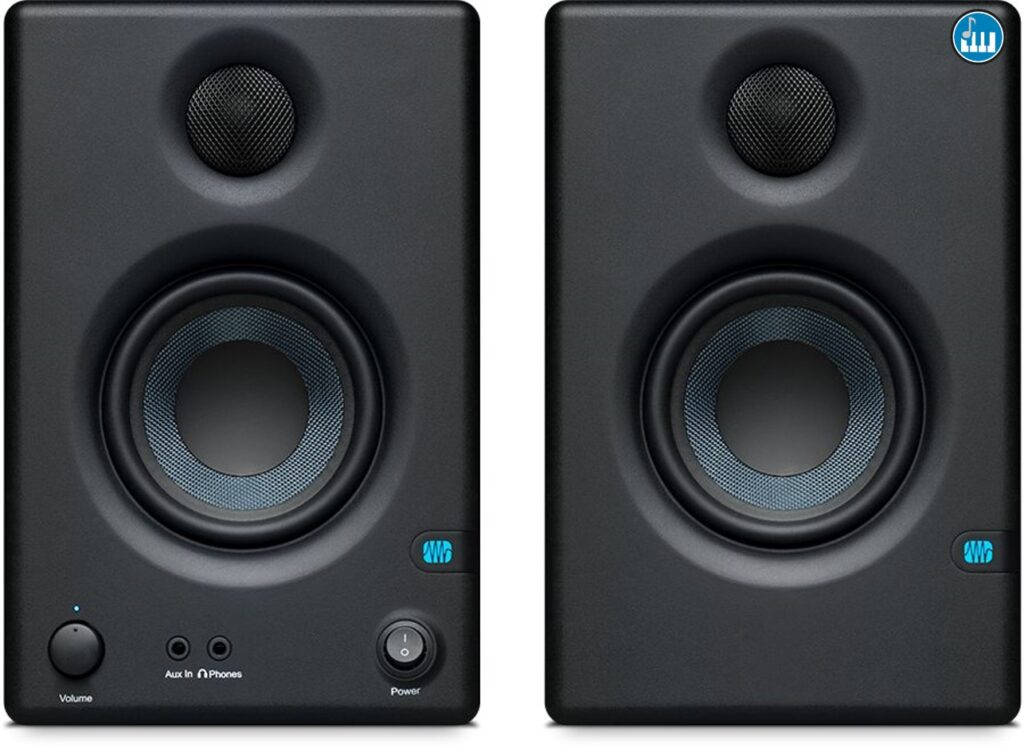
The PreSonus Eris E3.5 studio monitors are a super cheap option designed for reference and critical listening. Unlike most speakers in this price range, the E3.5 tuning has a more neutral response with great transient response thanks to its kevlar LF driver. The HF driver is a standard sized 1” tweeter as opposed to the 0.75” tweeters commonly seen on speakers in this range.
High and low frequency boost/cut knobs allow for precise settings in different rooms. Input options include 2 balanced TRS and 2 unbalanced RCA inputs in the back and a 1/8″ aux in the front.
PreSonus Eris E3.5s and speakers of this size work best in smaller mixing rooms.
Technical specifications of the PreSonus Eris E3.5
- Driver: 3.5″ Kevlar woofer, 1″ silk dome tweeter
- Amplifier: 50W Class AB (25W per speaker)
- Inputs: 2 x 1/4″, 1 x dual RCA stereo, 1 x 1/8″ (aux input)
- Frequency response: 80Hz-20kHz
- Crossover Frequency: 2.8kHz
- Enclosure: rear port
- Controls: Level knob, HI and LO Tuning knobs
- Dimensions: 8.3″ x 5.6″ x 6.4″ / 21 x 14.1 x 16.2 cm
- Weight: 6.4 lbs. / 2.9 kg.

Advantages of the PreSonus Eris E3.5
Its price and quality for beginners are second to none. The jump in quality that users who came from cheap computer speakers feel is remarkable. Thus, this pair of speakers is excellent for critical listening, with accentuated treble and tight low-frequency response.
Cons of the PreSonus Eris E3.5
They are not noted for long-term durability. Also, compared to speakers in a higher price range, they are not as neutral, and you can feel a sharp drop in bass, which is partly explained by the size of the speakers. A subwoofer can fill in the lower frequencies that the PreSonus Eris E3.5 lacks.
General opinion of the PreSonus Eris E3.5
PreSonus has achieved the benchmark speakers for beginners. Thus, the Eris E3.5 at a super affordable price are the perfect option for those who are building their Home Studio and want to keep a limited investment. In summary, although it is not a monitor that promises an absolute first level studio sound, it does not claim to be, for its price and quality it is difficult to beat for those looking for cheap monitors.
Manufacturer website: Presonus
To get the most out of your recording studio you must choose the best DAW for recording, mixing and editing music for PC Windows, Mac and Linux.
The best studio monitors under $300
This range is the combination of cheap and professional. This is the entry line for anyone looking for affordable professional gear. Thus, we could call it the “entry level” or “prosumer” category. In this price range you can find the latest technology for the growing needs of your study. You’ll also find flexible room compensation options, better electronics, and better driver materials.
KRK ROKIT 5 G4
Street price: $169 / £125 / €146.50 per unit – $338 / £250 / €293 per pair

The KRK ROKIT RP5 series, or simply 5, has been a staple in countless home recording studios. Its latest version, the ROKIT 5, 4th generation, loses the round egg-like curves of its predecessors in favor of a more traditional case with rounded corners. Also, it has a 5″ Kevlar woofer and a 1″ Kevlar dome tweeter. Adjustment of the controls is done in an app via Bluetooth, for better adjustments without leaving the “sweet spot”. In addition, it includes ISO foam pads to detach from surfaces.
Technical specifications of the KRK ROKIT 5 G4
- Driver: 5″ Kevlar Woofer, 1″ Kevlar Dome Tweeter
- Amplifier: 55W Class D
- Inputs: 1 XLR-1/4 combo
- Frequency response: 43Hz-40kHz
- Crossover Frequency: 3kHz
- Enclosure: Ported
- Controls: Controlled via app
- Dimensions: 11.22″ x 7.48″ x 9.49″ / 28.5 x 19 x 24.1 cm
- Weight: 10.69 lbs. / 4.85 kg.

Advantages of the KRK ROKIT 5 G4
While previous ROKIT generations were criticized for having a bloated low-end range, the ROKIT 5 G4 has refined its sound signature and beefed it up with a front port. Many users love the flat yet extended response despite being on the smaller scale of studio monitors. EDM producers are happy to still have low-frequency extension with a more balanced midrange. This allows a better translation of the mix. They are excellent monitors for a relatively low price.
Cons KRK ROKIT 5 G4
The digital controls are a bit gimmicky.
General opinion of the KRK ROKIT 5 G4
The ROKIT 5 G4 has converted former skeptics of the ROKIT line. With generation 4 of recording monitors, they have improved their sound signature which is more balanced. In addition, the more professional aesthetics attract more recording technicians and musicians who want to build an affordable Home Studio. Without a doubt, the KRK ROKIT 5 G4 has earned its place as a serious competitor in the low price range.
Manufacturer website: KRK
Also, if you are looking to build a Home Studio with little investment, you should consider having the best cheap Condenser microphone.
Adam Audio T7V
Street price: $275 / £169 / €198 per unit – $ 550 / £338 / €396 per pair
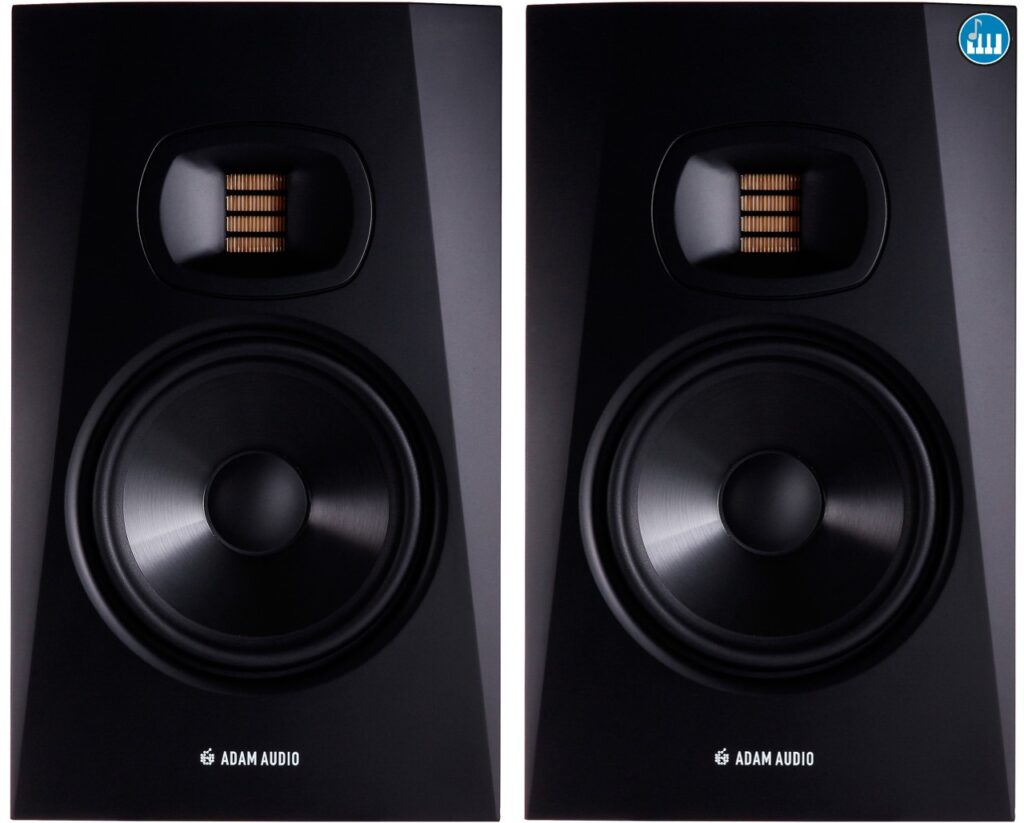
Adam Audio studio monitors are becoming a favorite with the music production and recording community thanks to their X-ART Ribbon tweeter technology and fast transient response.
Thus, its original patented tape design from its “A” series joins the more affordable “T” line. Additionally, the T7V features a U-ART ribbon tweeter capable of extending high-frequency projection up to 25khz.
ADAM Audio T7V Technical Specifications
- Driver: 7″ woofer, 1.9″ diameter equivalent ribbon tweeter
- Amplifier: 50W LF, 20W HF
- Inputs: 1x XLR, 1x RCA
- Frequency Response: 39Hz – 25kHz
- Crossover Frequency: 2.6kHz
- Enclosure: Ported
- Controls: Input Sensitivity, High Shelf, Low Shelf
- Dimensions: 13.7″ x 8.3″ x 11.5″ / 46.23 x 30.48 x 39.12 cm
- Weight: 15.7 lbs. / 7.1 kg.
ADAM Audio T7V frequency response graph

Advantages of the ADAM Audio T7V
The reproduction of high frequencies is one of the best you can find in this price range. Thus, these home studio monitors are super useful for balancing cymbals, synths, and other layers with intense high-frequency content. Despite the extended high frequencies, the Adam Studio T7Vs never get harsh or fatiguing. Clear highs also contribute to a great stereo image and strong phantom center for mono tracks. Imaging from the T7Vs is good, presenting an incredibly wide and expansive soundstage.
Cons of the ADAM Audio T7V
None significant for this price level, although a power indicator light would be handy.
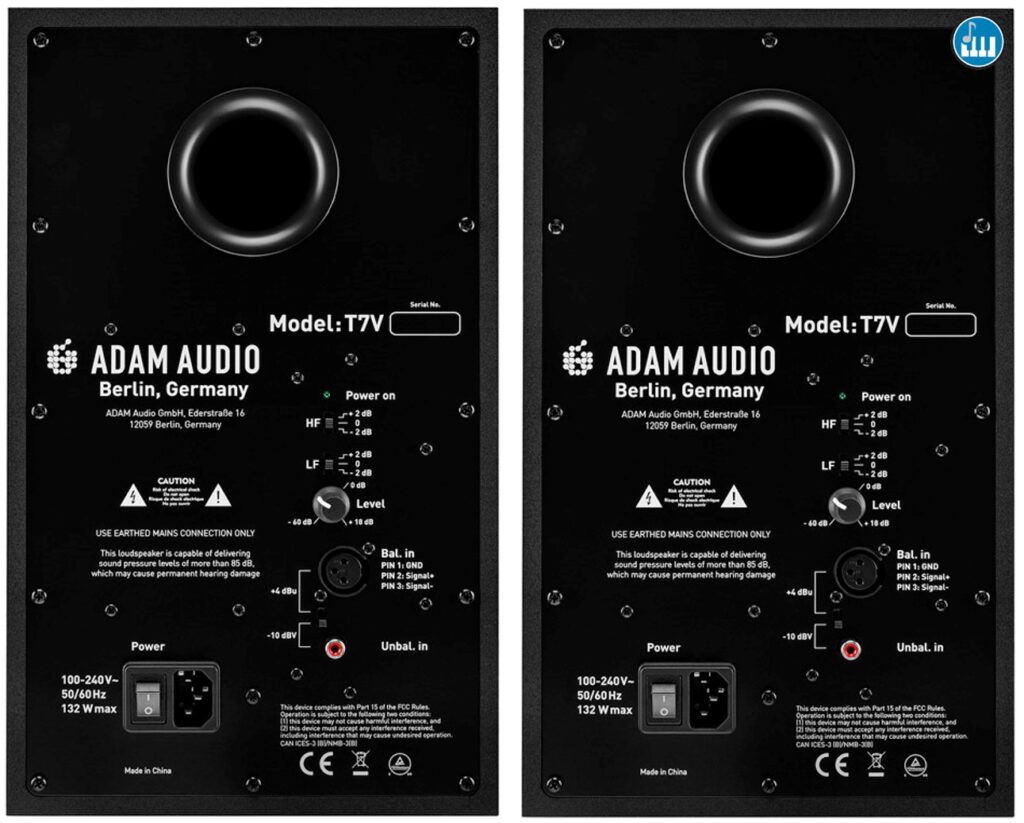
General opinion of the ADAM Audio T7V
If you’ve been following the company for a while, you’ll know that their “A” series monitors are becoming modern studio standards. Many hit Country, Rock and Heavy Metal records from the 2010s were mixed in the A-series. Buy these Adam Audio T7V monitors if you’re looking for crisp highs. But be careful if your room is small or untreated; high frequencies may not be routed correctly.
Manufacturer Website: Adam Audio
You might also be interested in having the best MIDI controller keyboard for amateurs and professionals for your recording studio.
JBL 305P Mk II
Street price: $149 / £111 / €130 per unit – $298 / £222 / €260 per pair

The JBL 305P MkII is the evolution of the JBL LSR 305. Thus, the 305P MkII studio monitor has an improved tweeter and woofer design that allows for less distortion at higher volumes. It also includes new limit settings in the back panel to help fine tune in your home studio.
Additionally, it features a specially designed “Picture Control” waveguide found in their high-end Reference M2 and 7-series loudspeakers.
Technical specifications of the JBL 305P MkII
- Driver: 5″ woofer, 1″ tweeter
- Amplifier: 41W LF, 41W HF
- Inputs: 1 x XLR, 1 x 1/4″
- Frequency Response: 39Hz – 25kHz
- Crossover Frequency: 1725Hz
- Enclosure: Ported
- Controls: Input Sensitivity, Limit EQ, HF Trim, Volume
- Dimensions: 11.7″ x 7.3″ x 9.1″ / 29.8 x 18.5 x 23.1 cm
- Weight: 10.43 lbs. / 4.73 kg.
JBL 305P MkII Frequency Response Graph
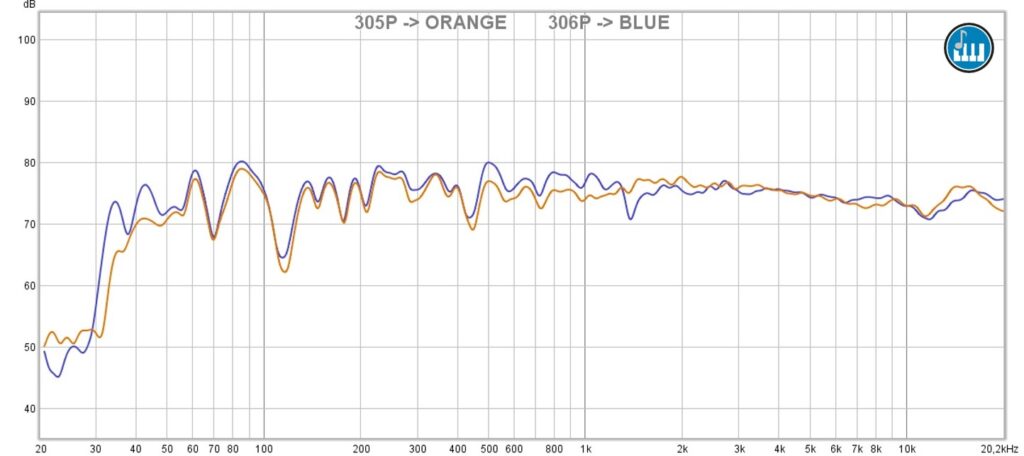
Advantages of the JBL 305P MkII
The JBL 305P MkII monitors have great sound quality very similar to higher priced products. Thus the highs and mids are praised for being neutral with the wide sweet spot giving these speakers ‘dimension’. Its build quality is also noteworthy.
Cons of the JBL 305P MkII
The 5″ speakers don’t push enough air for many heavy bass songs. So you may require a subwoofer to complement the monitors.

General opinion of the JBL 305P MkII
The JBL 305P MkII studio monitors are one of the best sellers among amateurs and professionals for their sound and build quality, as well as their affordable price. While it lacks bass, this could be an advantage for those who have relatively untreated rooms where too much bass could end up saturating the sonic sphere.
Manufacturer website: JBL Professional
We also recommend that you download the free Camel Crusher VST plugin for edit your mixes.
The best studio monitors under $500
Recording studio monitor manufacturers offer their mid-high level products in this price range. Thus, products at this price point generally have technology carried over from their higher-end products of the previous generation. But make no mistake, this does not mean that the technology can be obsolete or bad, quite the opposite. In this way, you can access higher-level technology without having to invest a lot of money.
Yamaha HS7
Street price: $330 / £188 / €220 per unit – $ 660 / £376 / €440 per pair

Yamaha continues to be the benchmark brand for studio monitors. Yamaha monitors are easy to spot, with their distinctive white cone woofers; an element inherited from his legendary NS-10 loudspeaker.
The Yamaha signature sound is a flat low midrange, tight low end, and a brutally revealing upper midrange spike that makes EQ errors painfully apparent.
It has a 6.7″ woofer paired with a 1″ dome tweeter mounted in a vibration dampening material to eliminate unwanted resonance for sound without distortion or coloration. Another notable feature is the use of larger magnets and an advanced magnetic circuit design to match.
Finally, the HS7 comes with Room and Treble switches on its rear panel to adjust the sound to the acoustics of your listening area / room.
Technical specifications of the Yamaha HS7
- Driver: 6.7″ woofer, 1″ dome tweeter
- Amplifier: 60W LF, 35W HF
- Inputs: 1 x XLR, 1 x 1/4″ (TS)
- Frequency response: 43Hz-30kHz (-10dB)
- Crossover Frequency: 2kHz
- Enclosure: Ported
- Controls: Level Knob, Room Control Switch, High Trim Switch
- Dimensions: 13.1″ x 8.3″ x 11.2″ / 28.4 x 21 x 33.2 cm
- Weight: 18.1 lbs. / 8.2 kg.
Yamaha HS7 Frequency Response Graph

Advantages of the Yamaha HS7
The Yamaha HS7 home studio monitor is notable for its “flat” response, which gives it a very natural sound. The highs and mids are very clear and transparent, while the lows are perfect for most mixing and mastering scenarios. Also, these recording monitors feature solid construction and excellent knob feel. Thus, the HS7 shows that Yamaha has refined the HS series to provide a small power near field that you can use with confidence, especially if you are used to working with the NS10.
Cons of the Yamaha HS7
There are no relevant observations about the sound.

General opinion of the Yamaha HS7
The HS7 is the perfect middle ground for someone who wants a home recording studio monitor with good sound quality but without shelling out a huge sum of money. Compared to its little brother, the HS5, the HS7 has those low frequencies that the HS5 may lack.
Manufacturer Website: Yamaha
In addition, you might be interested in adding the best cheap electronic drum kit to your home recording studio.
Kali Audio IN-5
Street price: $349 / £179 / €210 per unit – $698 / £358 / €420 per pair

At first glance, the IN-5 looks like a normal bi-amped studio monitor. On closer inspection, the midrange driver and high-frequency driver are arranged coaxially with the midrange driver also essentially functioning as a waveguide.
Large magnets and voice coils on the drivers along with a tri-amp configuration provide high headroom and low distortion. A low turbulence front firing port prevents snorting and distortion. Boundary EQ at the back helps tailor the speakers to your room.
Kali Audio IN-5 Technical Specifications
- Driver: 5″ Woofer, 4″ Paper Midrange Driver, 1″ Textile Dome Tweeter
- Amplifier: 80W LF, 40W mF, 40W HF
- Inputs: 1 x XLR, 1 x RCA, 1 x 1/4″
- Frequency response: 39Hz-25kHz (-10dB)
- Crossover Frequency: Not Specified
- Cabinet: front port
- Controls: Volume, High Trim, Low Trim
- Dimensions: 15.1″ x 8.2″ x 11.2″ / 38.6 x 28.5 x 20.6 cm
- Weight: 19 lbs. / 8.4 kg.
Kali Audio IN-5 Frequency Response Chart

Advantages of the Kali Audio IN-5
The Kali Audio IN-5 stands out for its linear “sweet spot” nature, strong stereo field, and the images they project. This helps the recording engineers to work on their mixes. It is also noted that the frequency response is neutral and translates well. The value for money offered by the IN-5 is outstanding.
Kali Audio IN-5 Cons
Nothing relevant to mention.

Kali Audio IN-5 Overview
The Kali Audio IN-5 is a showcase of modern speaker design. Thus, this recording studio monitor has a neutral frequency response and excellent value for money.
Manufacturer Website: Kali Audio
Also, you could use the best free online virtual drum machines in your Home Studio.
Genelec 8010A
Street price: $350 / £248 / €290.50 per unit – $698 / £496 / € 581 per pair
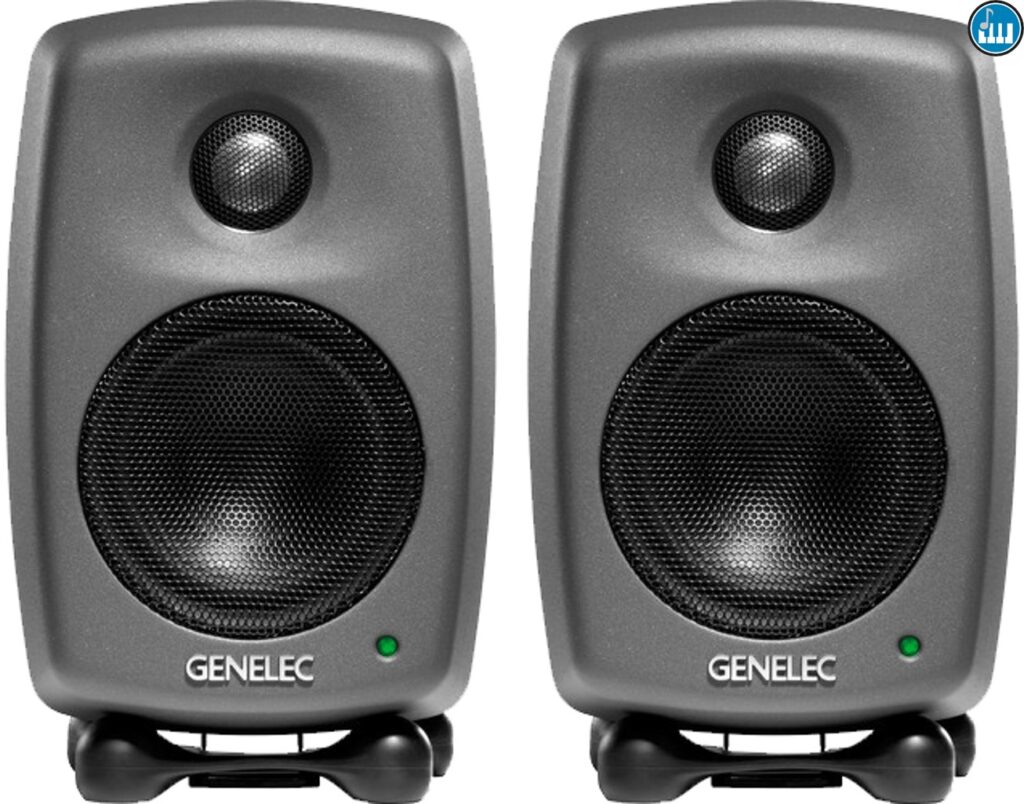
The Genelec brand of monitors is found in many of the world’s top recording studios. Despite the size, the 8010A will surprise you with its powerful bass and excellent imaging thanks to its minimal distortion.
The Genelec MDE -Minimum Diffraction Enclosure- brand design ensures phase accuracy by scattering reflections that would disrupt images.
Technical specifications of the Genelec 8010A
- Driver: 3″ woofer, 0.75″ dome tweeter
- Amplifier: 25W LF, 25W HF
- Inputs: 1 x XLR
- Frequency response: 43Hz-30kHz (-10dB)
- Crossover Frequency: 2kHz
- Enclosure: Ported
- Controls: Level Knob, Room Control Switch, High Trim Switch
- Dimensions: 8.3″ x 5.6″ x 6.4″ / 19.5 x 11.5 x 12.1 cm
- Weight: 3.3 lbs. / 1.5 kg.
Genelec 8010A Frequency Response Table

Advantages of the Genelec 8010A
The Genelec 8010A Studio monitors are built to excellent engineering standards just like the 8000. This monitor really doesn’t feel like a “budget version” of a Genelec. Thus, the 8010A is a well-designed portable studio monitor with great low-frequency extension and imaging for its small size. These speakers really sound bigger than they look.
Cons of the Genelec 8010A
The positioning of the XLR output does not allow some longer XLR plugs to fit.
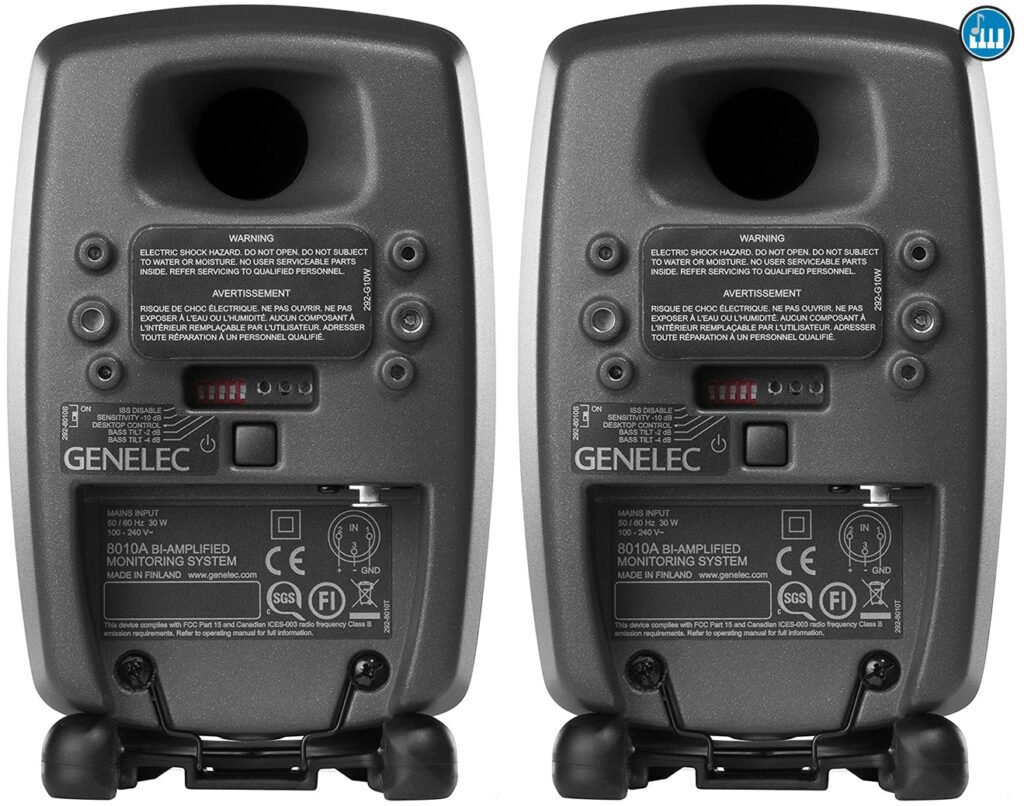
General opinion of the Genelec 8010A
The Genelec 8010A honors the quality and professionalism of the brand. If you’re looking for a compact nearfield monitor with excellent spread and low-frequency imaging, the 8010A is an excellent choice.
Manufacturer Website: Genelec
Maybe you might be interested in having the best keyboard to make Beats.
Yamaha HS8
Street price: $399 / £248 / €290.50 per unit – $798 / £496 / € 581 per pair

Yamaha continues to enjoy a favorable position in the nearfield monitoring market thanks to the success of the now legendary NS10 studio monitor. Larger than the 6.7” Yamaha HS7 monitor woofer, the 8” woofer allows for more headroom and low-frequency response. Additionally, the room and high trim controls will allow you to adjust the sound to suit different studio sizes.
Yamaha did a great job with this studio monitor, delivering an outstanding monitoring experience that is reflected in its high ratings and expert recommendations. It also helps that the HS8 is relatively affordable relative to its high quality.
Technical specifications of the Yamaha HS8
- Driver: 8″ woofer, 1″ dome tweeter
- Amplifier: 75W LF, 45W HF
- Inputs: 1 x XLR, 1 x 1/4″ (TS)
- Frequency Response: 38Hz to 30kHz
- Crossover Frequency: 2kHz
- Enclosure: Ported
- Controls: Level Knob, Room Control Switch, High Trim Switch
- Dimensions: 9.8″ x 15.4″ x 13.1″ / 25 x 39 x 33.4 cm
- Weight: 22.5 lbs. / 10.2 kg.
Yamaha HS8 frequency response graph

Advantages of the Yamaha HS8
Accurate, reliable, and durability are attributes that define the Yamaha HS8 recording monitors. The professional performance of these monitors stands out despite their affordable price. Thus, these Yamaha HS8 monitors come very close to the quality of other options in the higher price range. There are users who have used them for the last 4 or more, and continue to keep them, satisfied with their solidity and warmth. So no matter if you are a beginner or experienced producer or musician they will fulfill all your needs and more.
Cons of the Yamaha HS8
These home studio monitors may be too large for small and/or not properly treated rooms; and thus affect accuracy due to reflections and resonance. In that situation, the little brother HS5 may be a better option. In some cases they may suffer from interference from other devices. For some producers of musical styles with very bass-heavy songs, the Yamaha HS8 may be lacking in sufficient bass.

General opinion of the Yamaha HS8
The Yamaha HS8 carries on the legacy of the NS-10. Thus, this studio monitor is a safe middle ground for those looking for quality, reliability, versatility, and durability. It’s a monitor that stands out for its revealing flat frequency response. On the other hand, for small and not properly treated studies, they can be a bit large.
Manufacturer Website: Yamaha
If you dedicate yourself to electronic styles you should look at our guide on how to make Beats online and for free with the best apps for Beatmakers.
The best studio monitors under $1000
In this price range, most companies offer their flagship models. This means that the technology here is at the cutting edge or where the lower-end models get something from it. Other companies with more expensive offers place their offers from “prosumer” to “home professional” here. For other brands, this is where they introduce speakers with larger woofer diameters and cabinet sizes.
Genelec 8020D
Street price: $535 / £349 / €409 per unit – $ 1,070 / £698 / € 818 per pair

Genelec has a long history of making great, high-end studio monitors. But Genelec has developed a line of compact 4″ professional monitors for smaller studios.
The Genelec 8020D features the brand’s signature Diffraction-Lowest enclosure shape that reduces reflections in the speaker itself, as well as Directivity Control waveguide for better directivity.
Despite its size, it’s powered by a 50W LF driver for better headroom at higher monitoring levels.
Technical specifications of the Genelec 8020D
- Driver: 4″ woofer, 0.75″ diameter equivalent ribbon tweeter
- Amplifier: 50W LF, 50W HF
- Inputs: 1x XLR, 1x RCA
- Frequency response: 56Hz-25kHz (-6dB)
- Crossover Frequency: 3.0kHz
- Enclosure: Ported
- Controls: Tone DIP Switches, Sensitivity Control
- Dimensions: 9.5″ x 6″ x 5.6″ / 23 x 15.1 x 14.2 cm including Iso-Pod mount
- Weight: 7.0 lbs. / 3.2 kg.
Genelec 8020D Frequency Response Table

Advantages of the Genelec 8020D
The Genelec 8020D is one of the best desktop monitor solutions for smaller home setups with limited space. Sound aside, the included Iso-pod stands do a great job of isolating the speakers from the surface to prevent them from resonating and altering response. Despite its small size, bass response is excellent.
Cons of the Genelec 8020D
Although it is a matter of taste, it is worth clarifying that some users may feel that the Genelec 8020D have too much high fidelity. Especially if you’re used to the frequency responses of Yamaha monitors.

General opinion of the Genelec 8020D
If you’re looking for a great set of hi-fi monitors for a small, desktop setup, the Genelec 8020D is the best option on our list.
Manufacturer Website: Genelec
You should also have the best free amp simulator software for guitar, they are a great tool for your home recording studio.
Genelec 8030C
Street price: $695 / £466 / €546 per unit – $1,390 / £932 / €1,092 per pair

The Genelec 8030C shares the same diffraction-minimum enclosure and directivity control waveguide as other studio monitors in the 8000 series. It also includes an Iso-Pod mount for better isolation from the surface, preventing resonance.
The low-distortion 5″ woofer and 3/4″ metal dome tweeter deliver great clarity for any genre. Thus, the Genelec 8030C is a top-tier monitor for professional home studios.
Genelec 8030C Technical Specifications
- Driver: 5″ woofer, 0.75″ tweeter
- Amplifier: 50W LF, 50W HF
- Inputs: 1 x XLR
- Frequency response: 47Hz-25kHz
- Crossover Frequency: 3kHz
- Enclosure: Ported
- Controls: DIP Switches for Desktop Mode, Treble Tilt, Bass Roll-Off, Bass Tilt
- Dimensions: 11.8″ x 7.4″ x 7.06″ / 29.9 x 18.9 x 17.8 cm with Iso-Pod
- Weight: 11 lbs. / 5 kg.
Genelec 8030C Frequency Response Table

Advantages of the Genelec 8030C
Sound transparency is what makes the Genelec 8030C stand out. Thus, it facilitates better mixing since it provides a better image of the mixture. Like any Genelec product, its build quality and long-term durability are excellent, complemented by its energy saving system.
Cons of the Genelec 8030C
Its price is a bit high, although it is worth its price. If you are a demanding music producer, it is worth the investment.

General opinion of the Genelec 8030C
If you are a demanding music producer looking for a mid-sized professional studio monitor, the 8030C is the best option on the market.
Manufacturer Website: Genelec
Check out our guide to the best keyboard and digital piano for hobbyists and professionals.
Neumann KH 120 A
Street price: $749 / £529 / €620 per unit – $ 1,498 / £1,058 / €1,240 per pair

Premium audio manufacturers Neumann created the KH120A studio monitors for Home Studio. KH stands for “Klein + Hummel”, a studio monitor company incorporated into the Sennheiser group of companies under the Neumann brand.
Neumann’s mathematically modeled dispersion waveguide ensures wide horizontal directivity with narrow vertical dispersion to prevent reflections from tabletop and console surfaces.
If you are looking to build a high-end mixing and mastering studio, the Neumann KH 120 A monitors are an excellent option.
Technical specifications of the Neumann KH 120 A
- Driver: 5.25″ LF driver, 1″ HF driver
- Amplifier: 50 W (continuous), 80 W (peak) LF, 50 W (continuous), 80 W (peak) HF
- Inputs: 1x XLR, 1x RCA
- Frequency response: 52Hz-21kHz
- Crossover Frequency: 2 kHz, 24 dB/octave
- Enclosure: Ported
- Controls: Low, Mid, High trim, Output level trim, Input gain
- Dimensions: 10.87″ x 7.12″ x 8.62″ / 27.7 x 18.2 x 22 cm
- Weight: 14.3 lbs. / 6.2 kg
Neumann KH 120 frequency response graph

Advantages of the Neumann KH 120 A
The KH 120 is one of the most neutral and natural sounding speakers on the market. It’s clearly visible in the frequency curve of this outstanding studio monitor. Thus, they are relentless monitors that allow you to listen in more detail and be able to go more in detail in mixing decisions.
Cons of the Neumann KH 120 A
Not many, although their price is the highest, they are worth every penny of their price.

General opinion of the Neumann KH 120 A
The Neumann KH 120 is a true critical listening studio monitor that evinces bad mixes but rewards the best ones with excellent translation. Thus, they are recommended for professional producers and retailers who go deep into their mixing and editing process.
Manufacturer website: Neumann
Things to Consider When Buying Studio Monitors
While most studio monitors are reasonably versatile, there isn’t one pair of monitors that can satisfy every music producer. Thus, you must choose according to which one suits your needs, room and budget. The best studio monitor for you will depend mainly on the type of music you are producing, your level of professionalism or amateurism, the space of your studio, and your budget.
You should consider having a variety of instruments in your recording studio, that’s why we leave you our reviews of the best cheap electric basses and the best cheap acoustic guitars.
Studio monitor speaker size
Most recording studio monitors have 2-way speakers where the sound is split into low frequencies (LF) and high frequencies (HF) and sent to two different speakers. HF driver sizes, also called tweeters, are mostly the same, around 1″ or 0.75″. But in the case of LF drivers, also called woofers, there are greater variations and it is important that you consider this when choosing the monitor for your studio.
The general rule of thumb is that the larger the woofers, the more low frequencies they can handle, while the smaller ones can better represent the mid frequencies. Thus, choose larger woofers if you expect to mix bass-heavy songs, while smaller woofers are recommended if you emphasize clarity in the mids, where most vocals and instruments are. But also consider the size and sound treatment of your studio room. The smaller and/or less treated is the studio room, the better small format monitors work.
Monitor frequency response
This indicates the range of frequencies that the recording studio monitor can handle. Generally this is directly related to the size of the HF and LF drivers. Wider frequency response can handle more types of musical instruments and styles of music; but these extra frequencies can compete for your attention, which can cause you to miss important sonic details.
If you’re primarily into electronic music and you’re a DJ, you’ll want larger monitors that can handle the extra low frequencies usually associated with such styles as Hip Hop, EDM, House, Rap, and Dubstep. On the other hand, if you’ll be working with acoustic instruments and vocals, the exaggerated bass can prevent you from mixing and balancing frequencies properly, so it’s best to opt for flat-response studio monitors.
We at GEARanking strongly recommend having, or at least testing, more than one set of monitors. Thus, you can have more sound references to work with.
Speaker power rating
The power rating of the amplifier, along with the size of the speakers, determines the headroom and the total volume limit of the recording monitors. For mixing, you need a volume that is just enough to cover your listening area, without muddying or distorting the sound. You also don’t want to tire your ears easily or disturb your neighbors, so volume that’s too loud isn’t any better either.
Studio mixing environment
The type of speaker to choose will also depend on your mixing environment. If your studio room is not properly treated, as is often the case in a home studio, it is best to choose smaller monitors and use headphones to check the balance of the low frequencies that the monitors will not reflect correctly by your monitors. This is because untreated rooms tend to bounce sound and have uneven resonances that can affect your perception of frequency levels.
On the other hand, larger speakers with higher volume can introduce a phenomenon called “standing waves” in spaces with parallel walls. This phenomenon causes low frequencies to accumulate in one place or to disappear entirely, depending on where you are in the room. Having rugs as absorbers and uneven surfaces like shelves near flat walls as diffusers can help. But if you have no plans to completely treat your recording studio room, go for speakers with 5” diameter woofers or less.
We recommend you download these free guitar effects pedal VST plugins.
Monitors Positioning and Sweet Pot
To get the most out of your recording studio monitors, you must place them correctly, so that you listen within the optimal position. Since each recording monitor has different baffle and waveguide designs, positioning to find the “sweet spot” or “Sweet Pot” will vary. Therefore, you should read the manual and adjust your position accordingly.
Speaker positioning has many other factors, so we recommend that you watch the following video to understand the importance and application of good monitor positioning.
If you have tried some of the recording studio monitors included in our selection, leave us a comment telling us about your experience.
Are there any other monitors you think we should consider? Please let us know and we’ll do a thorough review to see if it deserves to be included.




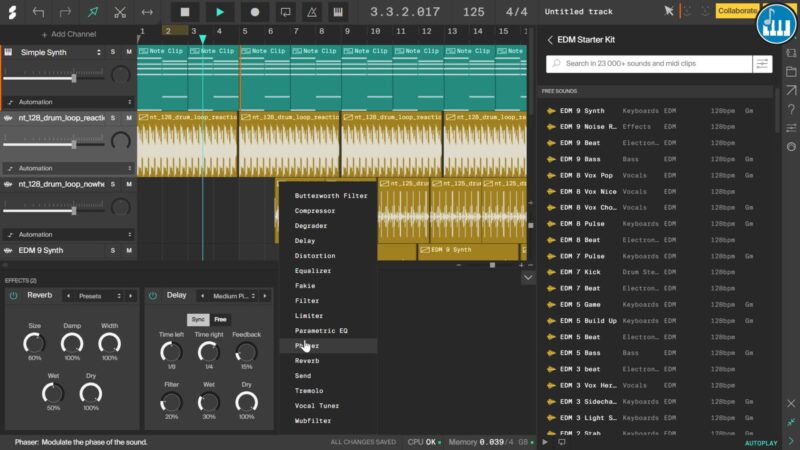


Room size. Everybody talks about it w/o specifying. I’m not a producer or mixer. I just listen. My room is 16x14x7. I currently have focal evo 65s. And kali in5 v2 and kali in8v2. The latter 2 are “coincident” in that the mid and high drivers are mounted in the same plane. I expected a remarkable difference vs the focals which are traditional 2 way but I can’t hear it. Am now thinking about genelec 8030c and Neumann kh 120. What do you think?
Hi Mark, thanks for your comment.
As you said, there are several aspects to consider, each room has its unique characteristics!
The G 8030 and the N kh120 are the best options.